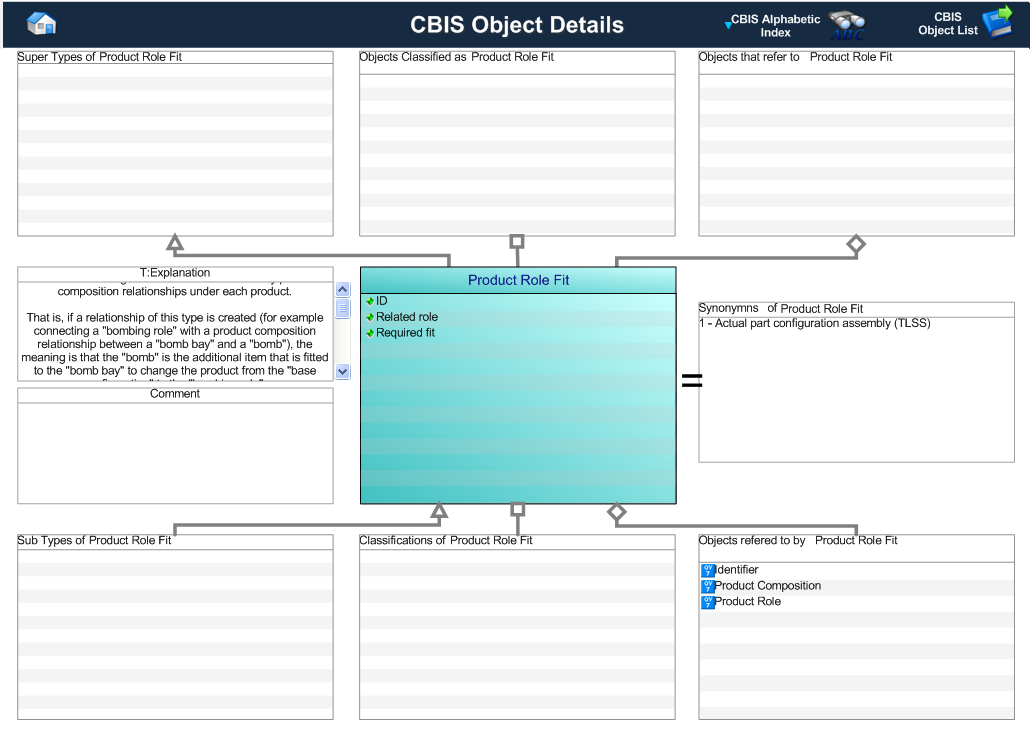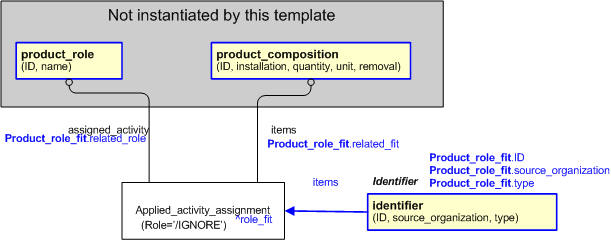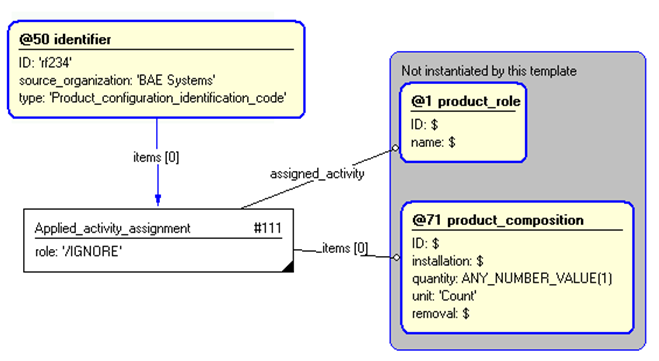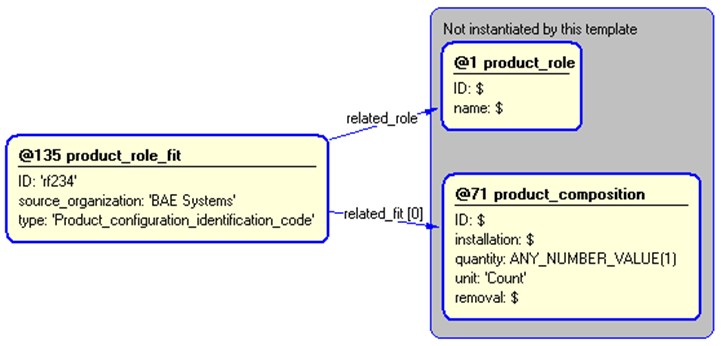Template:— product_role_fit (prod_r_f)
Context:— UK_Defence |
Date: 2009/04/17 11:04:01
Revision: 1.2
|
This section specifies the template product_role_fit.
NOTE
The template has been defined in the context of
UK_Defence.
Refer to the business context for details of related templates.
NOTE
An explanation of a template and the associated instantiation path is
provided in the
Template overview
section.
This template describes how to represent a UK_Defence product role fit, using
Applied_activity_assignment.
This information object represents the relationship between a named product role and the
actual assemblies that constitute it.
It is assumed that the relationships instantiated are in addition to the "base configuration" that is established
by
product composition relationships under each product.
That is, if a relationship of this type is created (for example connecting a "bombing role" with a product composition
relationship between a "bomb bay" and a "bomb"), the meaning is that the "bomb" is the additional item that is fitted
to the "bomb bay" to change the product from the "base configuration" to the "bombing role".
The "base configuration" itself could be explicitly defined using this relationship by connecting the "base configuration"
to every product composition that constitutes it, but it is not anticipated that it would add significant value
For further information about the representation of a product role fit, see below.
This information object represents the relationship between a named product role and the
actual assemblies that constitute it.
Figure 1 — Graphical Representation for Business Object Product Role Fit
Record:
This information object represents the relationship between a named product role and the
actual assemblies that constitute it.
|
Attribute name
|
Attribute description
|
Attribute type
|
Optionality
|
| ID |
This is the identifier of the product role fit. |
Identifier |
Mandatory |
| Related role |
This is the reference to the product role for which the related fit is required. |
Product Role |
Mandatory |
| Required fit |
This is the reference to the product composition relationship that is required to be
created in order that the product is configured correctly for the related role.
|
Product Composition |
Mandatory |
Table 1 — Product attribute details
The EXPRESS-G diagram in
Figure
2
shows the templates and EXPRESS entities that are required
to represent the template
"product_role_fit".
The text highlighted in blue shows the template parameters.
Figure 2 — An EXPRESS-G representation of the Information model for product_role_fit
The graphic for the template to be used in other EXPRESS-G diagrams
is shown in Figure
3
below.
Figure 3 — The graphical representation of the product_role_fit template
The following input parameters are defined for this template:
This is the identifier of the product composition
The organization that created the associated identifier. Additionally
a Person or Information System could be defined when either of these are the source; see Identifier template characterizations
This is the name of the type of the class used to classify the identifier and so
provide the role or reason for the identification.
The following classes and their sub-classes can be used:
This is the reference to the product role for which the related fit is required
This is the reference to the product role for which the related fit is required
The following reference parameters are defined for this template:
%^target = $product_role_fit.role_fit%
The following parameter combinations specify a uniqueness constraint:
Unique constraint: Unique role fit
The role and composition of the product should only occur once in a data set.
The instantiation path shown below specifies the entities that are to be
instantiated by the template.
A description of templates and the syntax for the instantiation path is
provided in the
Templates Help/Information section.
The following entities are instantiated with attributes as specified:
The instance diagram in Figure
4
shows an example of the EXPRESS entities and templates that are instantiated by the template:
/product_role_fit(id='rf234', source_organization='BAE Systems', type='Product_configuration_identification_code', related_role='@1', related_fit='@71')/
(an illustration of the consolidated product_role_fit template is shown in
Figure
5 below.)
Figure 4 — Entities instantiated by product_role_fit template
The instance diagram in
Figure
5
shows the graphic symbol for the template that is to be
used in other instance diagrams. The example template is:
/product_role_fit(id='rf234', source_organization='BAE Systems', type='Product_configuration_identification_code', related_role='@1', related_fit='@71')/
Figure 5 — Instantiation of product_role_fit template
Characterizations
No common characterizations of the template
product_role_fit
have been identified. However, the ISO 10303-239 EXPRESS model
may enable other assignments to the entities instantiated by the template.




